When to Plant Out Sunflowers
Sunflowers, with their vibrant blooms and towering presence, have long been a beloved addition to gardens and landscapes. Planting sunflowers at the right time is crucial for their successful growth and development. In this comprehensive guide, we will explore the optimal planting times for sunflowers, factors to consider, and provide valuable tips for nurturing these magnificent plants. Whether you’re a seasoned gardener or a beginner, this article, brought to you by PlantCoachCenter.com, will equip you with the knowledge to maximize your sunflower planting experience.
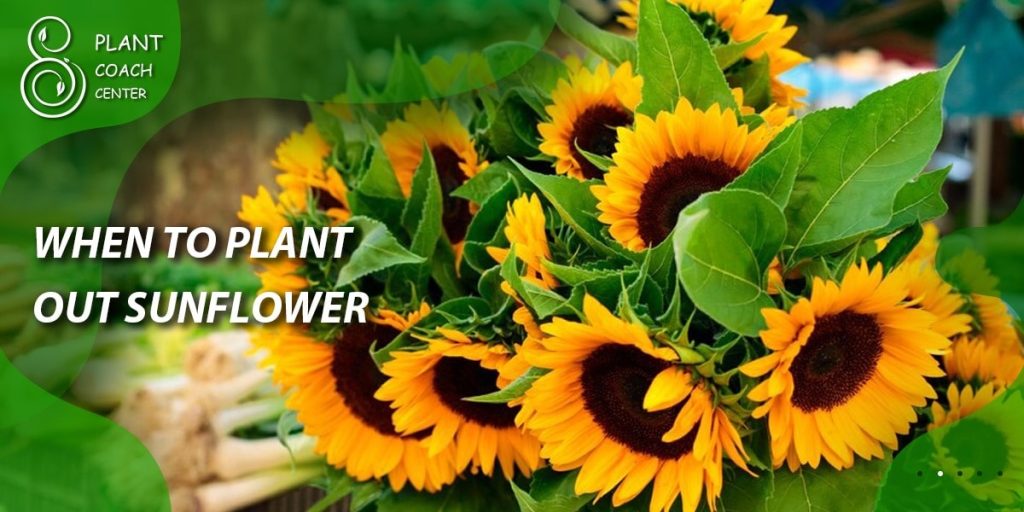
Understanding Sunflower Growth and Development
- Life Cycle of Sunflowers
Sunflowers undergo a fascinating life cycle, progressing from seed to mature plant. Understanding the different stages of their growth is essential for determining the appropriate time for planting out.
- Germination: Sunflower seeds require warmth, moisture, and proper soil conditions to germinate successfully. Germination typically occurs within 7 to 10 days after planting.
- Seedling Stage: During this phase, sunflower seedlings develop their first set of true leaves and establish a strong root system.
- Vegetative Growth: As the plant matures, it enters a period of vegetative growth, focusing on leaf production and stem development.
- Flowering Stage: The most captivating phase of sunflower growth, flowering brings forth the characteristic large, yellow (or other color) blooms that attract pollinators and mesmerize onlookers.
- Seed Development: Following pollination, the sunflower’s energy shifts towards seed production. The flower head gradually matures, and the seeds ripen.
- Factors Affecting Sunflower Growth
Several factors influence the growth and development of sunflowers. Understanding these factors will help you determine the optimal planting time for your sunflower seeds or seedlings.
- Temperature: Sunflowers thrive in warm climates, requiring soil temperatures of at least 50°F (10°C) for successful germination. Ideal daytime temperatures range between 70°F and 78°F (21°C and 26°C).
- Day Length: Sunflowers are photoperiodic plants, meaning their growth and flowering are influenced by the length of daylight. They typically require 10 to 12 hours of daylight to initiate flowering.
- Soil Quality: Well-draining soil with a pH range of 6.0 to 7.5 is ideal for sunflower growth. Loose, fertile soil enriched with organic matter provides the necessary nutrients for healthy plant development.

Selecting the Right Sunflower Varieties
- Popular Sunflower Varieties
Sunflowers come in various forms, each with its unique characteristics and purposes. Here are some popular sunflower varieties to consider:
- Giant Sunflowers: These varieties, such as ‘Russian Mammoth’ and ‘American Giant,’ can reach impressive heights and produce enormous flower heads, making them a favorite for competitions and ornamental purposes.
- Dwarf Sunflowers: Perfect for smaller spaces and containers, dwarf varieties like ‘Elf’ and ‘Sundance Kid’ offer compact growth habits and charming blooms.
- Pollen-Free Sunflowers: Some sunflower varieties, such as ‘Sunfinity’ and ‘ProCut,’ produce pollen-free flowers, making them ideal for cut flower arrangements and people with pollen allergies.
- Choosing Sunflowers Based on Purpose
Consider your intended purpose when selecting sunflower varieties:
- Ornamental Sunflowers: Opt for varieties with eye-catching colors and large flower heads, such as ‘Velvet Queen’ or ‘Autumn Beauty,’ to enhance your garden’s visual appeal.
- Edible Sunflowers: If you’re interested in harvesting sunflower seeds for snacks or culinary purposes, choose varieties bred for their seed quality, such as ‘Mammoth Russian’ or ‘Titan.’
- Cut Flowers: Select sunflowers with long stems and sturdy blooms, like ‘Sunrich Orange’ or ‘Lemon Queen,’ for creating stunning floral arrangements.
- Considerations for Climate and Region
Different sunflower varieties thrive in specific climates and regions. Consider the following factors when choosing sunflowers for your location:
- Hardiness Zones: Determine your USDA Hardiness Zone to identify sunflower varieties suitable for your region’s climate and temperature range.
- Day Length: Sunflowers with shorter growing seasons are better suited for regions with shorter summers or cooler climates.
- Regional Adaptation: Consult local gardening resources or speak with experienced gardeners in your area to identify sunflower varieties that have proven successful in your region.
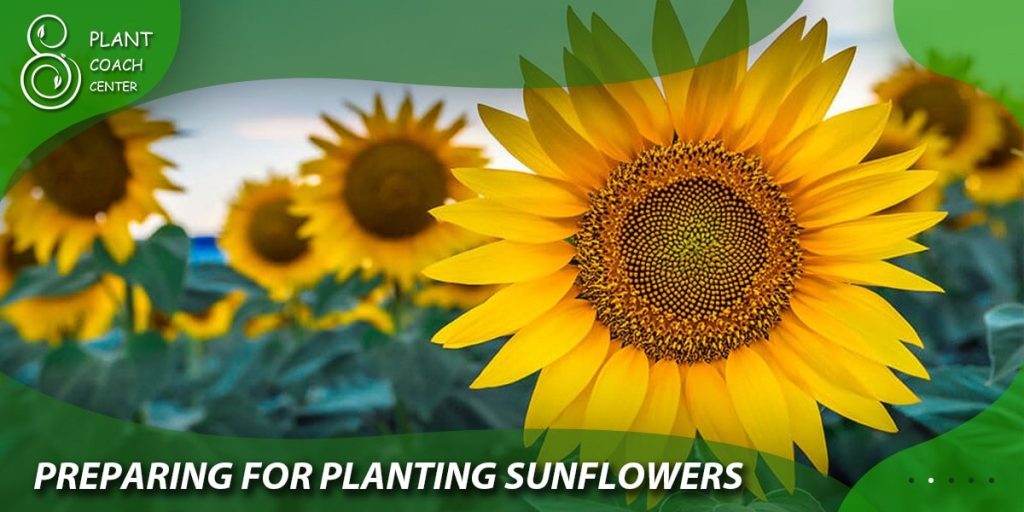
Preparing for Planting Sunflowers
- Soil Preparation
Before planting sunflowers, it’s vital to prepare the soil to create an optimal growing environment for these sun-loving plants.
- Soil Testing and Amendments: Conduct a soil test to assess nutrient levels and pH. Based on the results, amend the soil with organic matter, such as compost or well-rotted manure, to improve its fertility and structure.
- Sunflower Soil Requirements: Sunflowers prefer well-draining soil with moderate moisture retention. Avoid heavy clay soils that can become waterlogged and hinder root development.
- Sunflower Seeds and Seedlings
When it comes to planting sunflowers, you have two primary options: starting from seeds or purchasing seedlings.
- Seed Selection and Quality: Choose high-quality sunflower seeds from reputable suppliers. Look for seeds that are plump, firm, and free from damage or signs of mold.
- Starting Seeds Indoors: For regions with shorter growing seasons, starting sunflower seeds indoors a few weeks before the last frost date can give your plants a head start. Use biodegradable pots or peat pellets to minimize disturbance during transplanting.
- Purchasing Seedlings: If you prefer a more convenient option, purchase sunflower seedlings from nurseries or garden centers. Select healthy, vigorous seedlings with a well-developed root system.
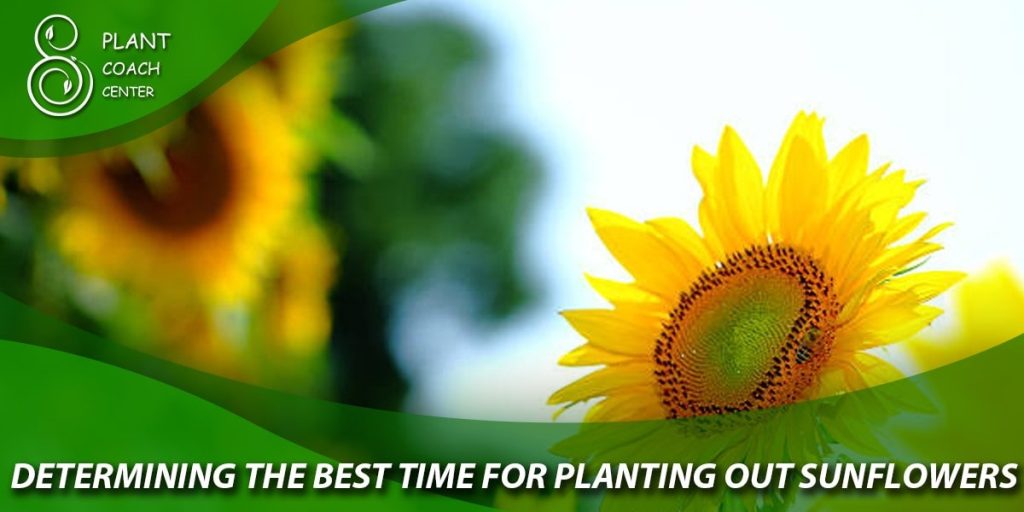
Determining the Best Time for Planting Out Sunflowers
- Understanding Frost Dates
Frost dates play a crucial role in determining the optimal time to plant out sunflowers. The last frost date in spring and the first frost date in fall serve as reference points for planning your planting schedule.
- Factors Influencing Planting Dates
Several factors influence the optimal planting dates for sunflowers, including:
- Soil Temperature: Ensure that the soil has warmed up to at least 50°F (10°C) before planting sunflowers. Cold soil can hinder germination and weaken seedlings.
- Day Length: Sunflowers require longer days to thrive. Planting them when the days are lengthening and the risk of frost has passed ensures they have adequate time to grow and mature.
- Regional Considerations and Planting Zones
Consider your region’s climate and planting zone when determining the best time to plant sunflowers. Consult local gardening resources, extension offices, or experienced gardeners for specific recommendations tailored to your area.
Early Spring Planting
- Advantages and Challenges
Planting sunflowers early in the spring can offer certain advantages and unique challenges to consider.
Advantages:
– Early planting allows for an extended growing season, providing ample time for sunflowers to reach maturity.
– Sunflowers planted early may bloom earlier, enhancing your garden’s visual appeal sooner.
– Cooler temperatures during the early spring can help sunflowers establish strong root systems.
Challenges:
– Risk of late spring frost: Early spring planting carries the risk of unexpected late frosts that can damage or kill young sunflower seedlings.
– Unpredictable weather conditions: Early spring weather can be unpredictable, with fluctuating temperatures and rainfall patterns that may impact sunflower growth.
- Tips for Successful Early Spring Planting
To maximize success when planting sunflowers early in the spring:
– Monitor weather forecasts closely and avoid planting if a late frost is expected.
– Consider using protective measures, such as row covers or cloches, to shield young seedlings from cold temperatures.
– Start seeds indoors a few weeks before the last frost date to give your sunflowers a head start.
– Harden off seedlings gradually before transplanting them outdoors to help them acclimate to outdoor conditions.
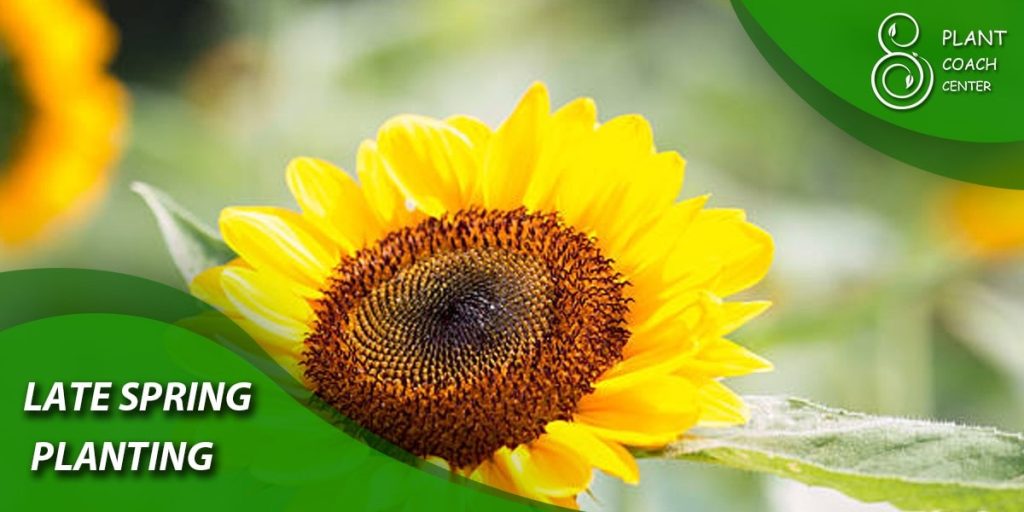
Late Spring Planting
- Advantages and Challenges
Late spring planting offers its own set of advantages and challenges for growing sunflowers.
Advantages:
– Reduced risk of frost: Planting sunflowers after the last frost date minimizes the risk of frost damage to young plants.
– Warmer and more stable temperatures: Late spring generally brings warmer and more consistent temperatures, providing optimal conditions for sunflower growth.
– Longer days: Sunflowers planted in late spring benefit from longer daylight hours, promoting vigorous growth.
Challenges:
– Competition with weeds: Planting later in the spring means that weeds may have already established themselves. Take appropriate weed management measures to ensure sunflowers have access to nutrients and sunlight.
– Limited time for growth: Late spring planting may result in a shorter growing season for sunflowers, particularly in regions with early fall frosts.
- Tips for Successful Late Spring Planting
To ensure successful late spring planting of sunflowers:
– Prepare the soil thoroughly by removing weeds and incorporating organic matter.
– Water newly planted sunflower seeds or seedlings adequately to support their establishment during potentially warmer and drier conditions.
– Select sunflower varieties with shorter growing seasons to maximize their chances of reaching maturity before the first fall frost.
– Monitor for pests and diseases, as warmer temperatures can increase the risk of infestations or infections.

Summer Planting
- Advantages and Challenges
Planting sunflowers during the summer months presents unique advantages and challenges to consider.
Advantages:
– Optimal growing conditions: Summer provides warm temperatures and abundant sunlight, which are ideal for sunflower growth and blooming.
– Longer days: Sunflowers planted in summer benefit from the longest days of the year, allowing for maximum photosynthesis and growth.
– Extended flowering period: Summer-planted sunflowers may have a prolonged flowering period, providing continuous beauty to your garden.
Challenges:
– Water requirements: Sunflowers planted during the summer may require more frequent watering due to higher evaporation rates and potentially drier conditions.
– Heat stress: High temperatures can stress sunflowers, especially if they are not provided with adequate moisture and some shade during the hottest parts of the day.
– Pests and diseases: Summer brings an increased risk of pests and diseases, such as aphids or fungal infections, which can impact sunflower health.
- Tips for Successful Summer Planting
To ensure successful summer planting of sunflowers:
– Choose sunflower varieties that are heat and drought-tolerant, as they are better suited for the summer growing conditions.
– Provide sufficient water to keep the soil consistently moist, especially during periods of prolonged heat or drought.
– Mulch around sunflower plants to help retain moisture in the soil and suppress weed growth.
– Monitor for pests regularly and take appropriate measures, such as using organic pest control methods, to prevent infestations.
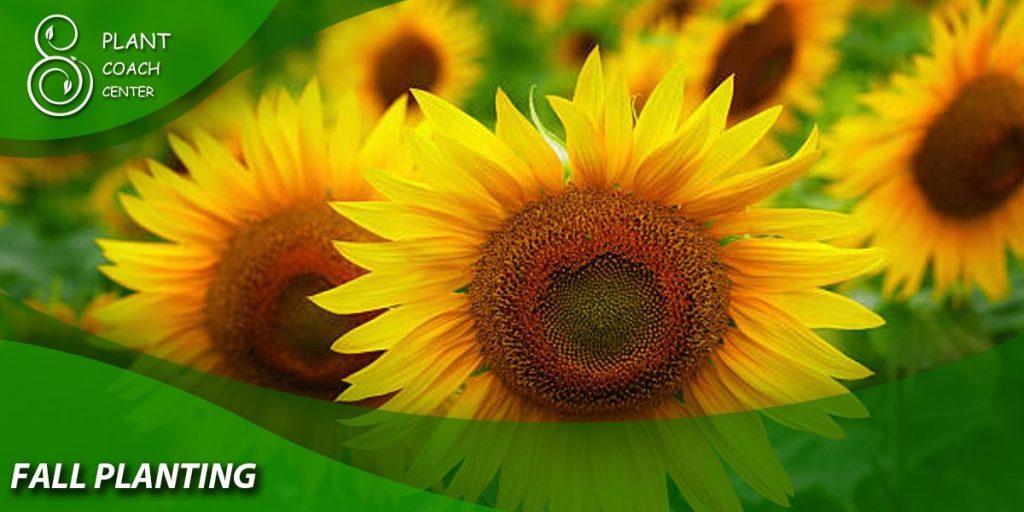
Fall Planting
- Advantages and Challenges
Fall planting of sunflowers offers unique advantages and challenges, particularly in regions with mild winters.
Advantages:
– Cooler temperatures: Planting sunflowers in the fall provides relief from scorching summer temperatures, reducing the risk of heat stress.
– Lower water requirements: Cooler fall temperatures decrease water evaporation rates, meaning less frequent watering may be required.
– Extended bloom duration: Sunflowers planted in the fall may have an extended flowering period, as they can take advantage of milder weather conditions.
Challenges:
– Limited time for growth: Fall-planted sunflowers have a shorter growing season before colder temperatures and frosts arrive.
– Potential for early frost: In regions with early fall frosts, sunflowers may need to be protected or harvested before the first frost to prevent damage.
- Tips for Successful Fall Planting
To ensure successful fall planting of sunflowers:
– Start with healthy seedlings instead of direct seeding to give sunflowers a better chance of reaching maturity before frost.
– Choose early-maturing sunflower varieties to maximize the chances of successful growth before colder weather arrives.
– Monitor weather forecasts closely and harvest sunflower heads promptly if an early frost is predicted.
– Consider using protective coverings, such as row covers or cold frames, to extend the growing season and protect sunflowers from frost.
Successful Fall Planting
Conclusion
Planting sunflowers at the right time is essential for their growth and overall success. By understanding the life cycle of sunflowers, selecting appropriate varieties, and considering the factors that influence their growth, you can make informed decisions about planting times. Whether you choose to plant in early spring, late spring, summer, or fall, each season presents its own advantages and challenges.
By following the tips and guidelines provided in this comprehensive guide, you can enjoy the beauty and rewards of growing sunflowers in your garden. For more gardening resources and information, visit PlantCoachCenter.com, where you can find additional tips, inspiration, and expert advice to enhance your gardening journey.







